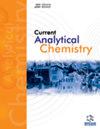HPLC-MS/MS Method for the Quantitative Determination of Metformin in Rat Plasma and Its Application to Comparative Bioavailability Assessment
IF 1.7
4区 化学
Q3 CHEMISTRY, ANALYTICAL
引用次数: 0
Abstract
Background:: Metformin is a biguanide derivative utilized as a first-line treatment for type 2 diabetes for people over 60 years. However, it faces certain limitations due to its incomplete absorption, resulting in a 50-60% bioavailability. In addition to its blood glucose-lowering effect, the antiproliferative effect of metformin has been demonstrated in vitro. Therefore, it is necessary to consider alternative administration routes that can enhance the bioavailability of metformin, expanding its clinical use beyond its role as an antidiabetic agent. Objective:: The aim of the study was to develop a reliable bioanalytical method for the quantitation of metformin in male Sprague-Dawley rat plasma and explore the promising alternative administration route for metformin use. Methods:: A robust, high-performance liquid chromatography-tandem mass spectrometry method for the quantification of metformin in rat plasma was developed and validated according to the latest regulatory guidance for bioanalysis. Results:: Based on the area under the curves obtained from the rat pharmacokinetic study, subcutaneous injection increased the systemic exposure of metformin by 1.79-fold compared to oral administration in rats. Conclusion:: Subcutaneous administration of metformin enhances its bioavailability compared to oral administration, leading to increased antidiabetic effects and potential antitumor activity.大鼠血浆中二甲双胍的 HPLC-MS/MS 定量测定方法及其在生物利用度比较评估中的应用
背景:二甲双胍二甲双胍是一种双胍类衍生物,是 60 岁以上人群治疗 2 型糖尿病的一线药物。然而,由于二甲双胍吸收不完全,其生物利用度仅为 50%-60%,因此面临着一定的局限性。除了降血糖作用外,二甲双胍还具有体外抗增殖作用。因此,有必要考虑其他给药途径,以提高二甲双胍的生物利用度,从而扩大其在临床上的应用,而不仅仅是作为一种抗糖尿病药物。研究目的本研究旨在开发一种可靠的生物分析方法,用于定量检测雄性 Sprague-Dawley 大鼠血浆中的二甲双胍含量,并探索二甲双胍的理想替代给药途径。方法::根据最新的生物分析监管指南,开发并验证了一种用于定量大鼠血浆中二甲双胍含量的高效液相色谱-串联质谱方法。结果根据大鼠药代动力学研究得出的曲线下面积,皮下注射与口服相比,二甲双胍的全身暴露量增加了 1.79 倍。结论与口服药物相比,二甲双胍皮下注射可提高其生物利用度,从而增强抗糖尿病效果和潜在的抗肿瘤活性。
本文章由计算机程序翻译,如有差异,请以英文原文为准。
求助全文
约1分钟内获得全文
求助全文
来源期刊

Current Analytical Chemistry
化学-分析化学
CiteScore
4.10
自引率
0.00%
发文量
90
审稿时长
9 months
期刊介绍:
Current Analytical Chemistry publishes full-length/mini reviews and original research articles on the most recent advances in analytical chemistry. All aspects of the field are represented, including analytical methodology, techniques, and instrumentation in both fundamental and applied research topics of interest to the broad readership of the journal. Current Analytical Chemistry strives to serve as an authoritative source of information in analytical chemistry and in related applications such as biochemical analysis, pharmaceutical research, quantitative biological imaging, novel sensors, and nanotechnology.
 求助内容:
求助内容: 应助结果提醒方式:
应助结果提醒方式:


